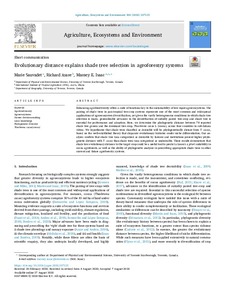| dc.contributor.author | Sauvadet, M. |
| dc.contributor.author | Asare, R. |
| dc.contributor.author | Isaac, M.E. |
| dc.date.accessioned | 2020-09-29T12:19:31Z |
| dc.date.available | 2020-09-29T12:19:31Z |
| dc.date.issued | 2020-12 |
| dc.identifier.citation | Sauvadet, M., Asare, R. & Isaac, M.E. (2020). Evolutionary distance explains shade tree selection in agroforestry systems. Agriculture, Ecosystems & Environment, 304: 107125, 1-4. |
| dc.identifier.issn | 0167-8809 |
| dc.identifier.uri | https://hdl.handle.net/20.500.12478/6955 |
| dc.description.abstract | Enhancing agrobiodiversity offers a suite of functions key to the sustainability of low input agroecosystems. The pairing of shade trees in pan-tropical tree-crop systems represents one of the most common and widespread applications of agroecosystem diversification, yet given the vastly heterogeneous conditions in which shade tree selection is made, generalizable advances in the identification of suitably paired tree-crop and shade tree is essential for performance and adoption. Here, we determine the phylogenetic distance between 78 reported shade tree genera and the dominant tree-crop, Theobroma cacao L (cocoa), across four countries in sub-Sahara Africa. We hypothesize that shade trees classified as desirable will be phylogenetically distant from T. cacao, based on the well-established theory that disparate evolutionary histories confer niche differentiation. Our analyses confirm that shade tree taxa categorized as desirable by farmers and institutions present higher phylogenetic distance with T. cacao than shade trees taxa categorized as undesirable. These results demonstrate that shade tree evolutionary distance to the target crop could be a useful tool to predict a taxon’s a priori suitability in cocoa agroforests, as well as the ability of phylogenetic analyses in prescribing appropriate shade trees in other current and future agroforestry systems. |
| dc.format.extent | 1-4 |
| dc.language.iso | en |
| dc.subject | Agrobiodiversity |
| dc.subject | Agroecosystems |
| dc.subject | Farmers |
| dc.subject | Decision Making |
| dc.subject | Indigenous Knowledge |
| dc.subject | Phylogeny |
| dc.subject | Theobroma Cacao |
| dc.title | Evolutionary distance explains shade tree selection in agroforestry systems |
| dc.type | Journal Article |
| cg.contributor.crp | Climate Change, Agriculture and Food Security |
| cg.contributor.crp | Forests, Trees and Agroforestry |
| cg.contributor.affiliation | University of Toronto - St. George Campus |
| cg.contributor.affiliation | International Institute of Tropical Agriculture |
| cg.coverage.region | Africa |
| cg.coverage.region | West Africa |
| cg.coverage.country | Cameroon |
| cg.coverage.country | Ghana |
| cg.coverage.country | Nigeria |
| cg.coverage.hub | Headquarters and Western Africa Hub |
| cg.researchtheme | Natural Resource Management |
| cg.identifier.bibtexciteid | SAUVADET:2020 |
| cg.isijournal | ISI Journal |
| cg.authorship.types | CGIAR and advanced research institute |
| cg.iitasubject | Aflatoxin |
| cg.iitasubject | Agronomy |
| cg.iitasubject | Cocoa |
| cg.iitasubject | Natural Resource Management |
| cg.journal | Agriculture, Ecosystems and Environment |
| cg.notes | First online: 27 August 2020 |
| cg.accessibilitystatus | Limited Access |
| cg.reviewstatus | Peer Review |
| cg.usagerightslicense | Copyrighted; all rights reserved |
| cg.targetaudience | Scientists |
| cg.identifier.doi | https://dx.doi.org/10.1016/j.agee.2020.107125 |
| cg.iitaauthor.identifier | Richard Asare: 0000-0001-6798-7821 |
| cg.futureupdate.description | Pagination to be changed when published |
| cg.futureupdate.required | Yes |
| cg.futureupdate.duration | 3 Months |

